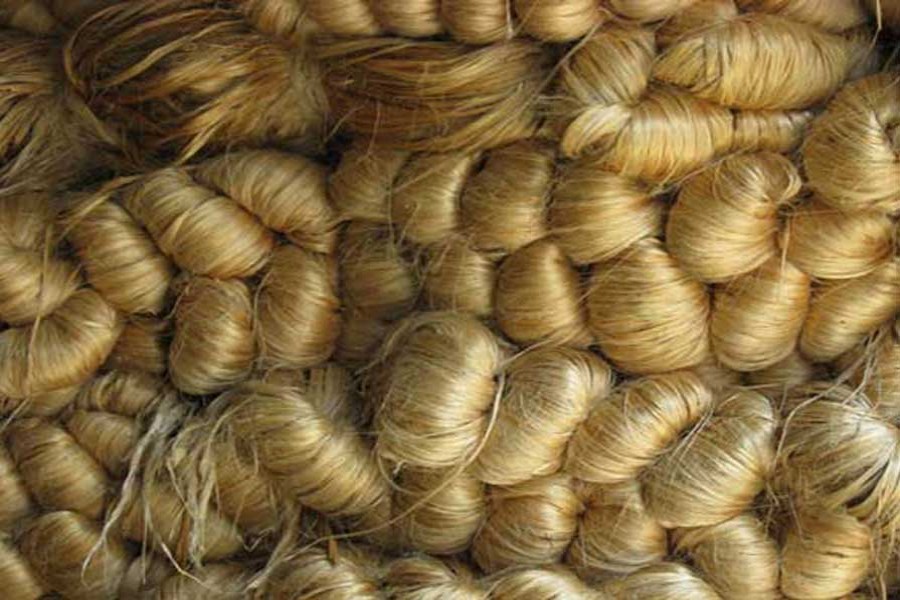The jute sector has a bright future and the state minister for textiles and jute hopes that it will overtake the ready-made garments (RMG) sector within five years.
The jute industry, which employs nearly 0.2 million workers, is the country's third largest export-earning sector after garments and leather. Its production was 6.5 million bales in 2014. It increased to seven million bales in 2015, 8.5 million in 2016 and 9.2 million bales in 2017. The sector is currently producing 240 types of jute products.
One hopes the planned "Jute Village" on the outskirts of Dhaka city will help revive the past and lost glory of the fibre. The authorities have also other development plans including a 'Handloom Village' with near the capital.
The government has taken a number of initiatives to increase export of jute and jute goods to the international market. Efforts are being taken to conduct a research on international market and promote entrepreneurs to produce diversified products. The jute ministry is also planning to produce high quality jute seeds in the country as Bangladesh is largely dependent on India for seeds.
Prime Minister Sheikh Hasina, at a recent meeting, called for working sincerely in order to unlock the huge potential of jute and jute products. She highlighted the multipurpose use of jute which can expedite our socioeconomic development.
Jute and jute products have good demand both in the country and abroad as people are now very much aware about the need to use eco-friendly items. It's time to regain the past glory of jute and its products. Proper policy support and adjustment of fiscal burden could help the jute sector become one of the important economic growth drivers of the country.
In another development, Finance Minister AMA Muhith said the country's jute mills should function autonomously under public-private partnership (PPP). There is no need of the Bangladesh Jute Mills Corporation (BJMC). This loss-incurring entity should immediately be shut down as a better way for jute-sector revival, he added.
In defence of his remarks, the finance minister said the government wants revival of jute sector, as a new market of the 'golden fibre' has been created. But he does not see the effectiveness of the BJMC. Instead, a cell at the ministry should look after the affairs of the jute mills, he said.
In spite of the hard stance against the BJMC by the finance minister, state minister for Textile and Jute Mirza Azam has all praise for the corporation. He said the BJMC is playing a positive role in developing jute industrial villages on its unused lands for the diversification of products made from the natural fibre. All procedures have been taken up to develop such villages. The ministry gave its consent to develop such villages based on a feasibility report submitted by a panel of experts, he claimed.
There are specialised areas, such as weaving villages, in the country and the idea of developing jute industrial villages is derived from that to promote small and medium enterprises. Products such as jute bags and sandals are set to be made in the small scale factories in the villages.
Of late, the country jute sector is facing some challenges due to India's imposition of anti-dumping duty (ADD). India imposed ADD in 2017 for a period of five years on jute products from Bangladesh at rates range between US$ 19.30 to $ 351.72 per tonne amid allegations of dumping of goods like jute yarn, twine, jute sacking bags and hessian.
As a result, exports of jute goods from Bangladesh to India declined from monthly average of over Tk 113 million in fiscal year (FY) 2015-16 to Tk 60 million in FY 2016-2017. Bangladesh exports more or less 30 per cent of its exportable jute goods to India, according to reports.
The country has now decided to take up the issue with the dispute settlement body of World Trade Organisation (WTO) following rejection of its appeal and repeated attempts for withdrawal of the anti-dumping measure by the Indian authorities.
It is now an established fact that Bangladesh can produce good quality pulp from jute and from this pulp high quality paper can be produced. In this regard, 'Jute Pulp Paper Act' could be beneficial for the entrepreneurs of this sector. World market for jute bag will reach US$2.6 billion by 2022. Bangladesh can seize this opportunity.
Bangladesh imports viscose worth US$700-800 million every year and this item is made of wood. The country has the potential to produce viscose from jute. There should be coordination between the forest research institute and the jute research institute.
Bangladesh earned $962.42 million from jute goods export during the fiscal year 2016-17 against $918 million in the FY 2015-16. If there are coordinated efforts, its export will increase up to US$5-7.0 billion a year. If the government gives special incentives and financial support, more entrepreneurs will enter this business.
Analysts say a domestic-guided market needs to be ensured for the jute and jute goods as the sector faced anti-dumping duty in export market. The country is making progress in jute diversification gradually, but the important part is proper government policy framework.
Rationalising the public sector jute mills in terms of size, as large-scale mills are getting low returns, is also very important. The production cost of the BJMC-run mills is much higher than the private sector jute mills. Despite providing financial support, these mills were still being operated in huge losses.
All said and done, there is the need for relentless efforts for developing a competitive jute sector. Its potential is huge and the private sector businesses will have to take the lead in the sector.
The government should, in the meantime, redesign overall incentive structure, allocating more resources for foreign direct investment, technological upgradation and creating skilled professionals for the jute sector.


